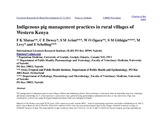| dc.contributor.author | Roschinsky, R | |
| dc.contributor.author | Mulindwa, H | |
| dc.contributor.author | Galukande, E | |
| dc.contributor.author | Wurzinger, M | |
| dc.contributor.author | Mpairwe, D | |
| dc.contributor.author | Okeyo, A M | |
| dc.contributor.author | Sölkner, J | |
| dc.date.accessioned | 2013-07-02T14:54:50Z | |
| dc.date.available | 2013-07-02T14:54:50Z | |
| dc.date.issued | 2012 | |
| dc.identifier.citation | Roschinsky, R., Mulindwa, H., Galukande, E., Wurzinger, M., Mpairwe, D., Okeyo, A. M., & Sölkner, J. (2012). Pasture use and management strategies in the Ankole pastoral system in Uganda. Grass and Forage Science, 67(2), 199-209. | en |
| dc.identifier.uri | http://onlinelibrary.wiley.com/doi/10.1111/j.1365-2494.2011.00834.x/abstract;jsessionid=DADBA6F9641AC938BEFA25612A74E5F5.d01t03?deniedAccessCustomisedMessage=&userIsAuthenticated=false | |
| dc.identifier.uri | http://erepository.uonbi.ac.ke:8080/xmlui/handle/123456789/44249 | |
| dc.description.abstract | The Bahima ethnic group have been crossbreeding autochthonous Ankole with Holstein-Friesian cattle. Separate herds (pure Ankole and crossbreds) are common. A survey was conducted to characterize pasture utilization and management in the Ankole region to gain a better understanding of current and emerging practices. Herds are largely grazed by continuous stocking although there are efforts to establish paddocks. Factors considered for pasture allocation to cattle genotypes were high-quality feed, limited shrubs/weeds and close proximity to homestead for 80, 80 and 30% of farmers, respectively. Cross-bred cattle were kept on medium/high-quality, and Ankole cattle on medium/low-quality pastures. Pastures for cross-bred cattle yielded 0·17 t ha−1 more dry matter than pastures allocated to Ankole cattle. Crude protein (CP) content of Ankole pasture was significantly (P < 0·05) lower than CP of cross-bred pasture (6·3% compared with 7·3%). Neutral detergent fibre content was similar (72·8% vs. 69·8%) for both pasture types. Farmers’ perceptions of indicator plant species were important for allocation of pasture. Hyparrhenia rufa, Brachiaria spp., Themeda triandra and Chloris gayana were identified as the preferred pasture species. Sporobolus pyramidalis and Cymbopogon afronardus were the most undesirable pasture species. Brachiaria spp. offers an opportunity for utilization as hay for dry season supplementation. | en |
| dc.language.iso | en | en |
| dc.publisher | University of Nairobi. | en |
| dc.subject | Ankole cattle | en |
| dc.subject | indigenous knowledge | en |
| dc.subject | pasture composition | en |
| dc.subject | pasture management;Uganda | en |
| dc.title | Pasture use and management strategies in the Ankole pastoral system in Uganda | en |
| dc.type | Article | en |
| local.publisher | Departrment of Animal Production | en |

